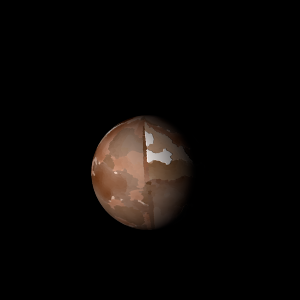|
|
Space Astro
|
Info for exoplanet "Kivi"
| Scientific (actual) data |
|---|
| Planet | Kepler-899 b |
| Planet status | Confirmed |
| Radius | 0.239 |
| Orbital period | 19.1789 |
| Discovered | 2016 |
| Updated | 2021-02-05 |
| Tconj | 2454970 |
| Publication | Announced on a website |
| Detection type | Primary Transit |
| Alternate names | 2MASS J19495582+4040508 b, K01585.01, KIC 5470739 b, KOI-1585 b, KOI-1585.01 |
| Star name | Kepler-899 |
| Right ascension | 297.48° |
| Declination | 40.68° |
| Mag j | 14.113 |
| Mag h | 13.725 |
| Mag k | 13.615 |
| Star distance | 1038 |
| Star metallicity | -0.06 |
| Star mass | 0.93 |
| Star radius | 0.91 |
| Star age | 4.07 |
| Star temperature | 5595 |
| Star alternate names | 2MASS J19495582+4040508, KIC 5470739, KOI-1585 |
| Wikipedia article | Kepler-899 b |
Back
| |
| Fictional info (?) |
|---|
| Suggested name | Kivi |
| Planet type | Cold planet |
| It has the longest rotation period (445 days) of any planet in its solar system and rotates in the opposite direction to most other planets.
Kivi is similar in composition to Narcal-epi, and both have different bulk chemical composition from that of the larger cold planets. Kivi's atmosphere is similar to Narcal-epi's in its primary composition of methane and ethane, but it contains more "ices" such as water, ammonia, and methane, along with traces of other hydrocarbons. The planet is named after the deity Kivi, the bringer of the sky.
At this time it may appear as a bright star-like object, but is often far more difficult to observe than Narcal-epi.
An observer on Kivi would therefore see only one summer every four years.
As one of the brightest objects in the sky, Kivi has been a major influence in native folklore for as long as records have existed.
The two polar ice caps appear to be made largely of sand. |
| Atmosphere | Methane | 34% |
| Ethane | 32% |
| Ozone | 23% |
| Carbon monoxide | 8.8% |
| Hydrogen chloride | 1.5% |
| Hydrogen peroxide | 0.0023% |
| Carbonyl sulfide | 0.00058% |
| Atmospheric pressure | 0.05 bar |
 |
| No known satellites |
| Google search for Kivi |
|
Website by Joachim Michaelis
|
|
|
|